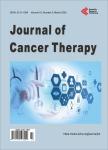Proteomic Profile Modification of Anaplastic Medulloblastoma after in-Vivo Radiotherapy: A Case Study
Proteomic Profile Modification of Anaplastic Medulloblastoma after in-Vivo Radiotherapy: A Case Study作者机构:Department of Genetics Biology and Biochemistry (CERMS) University of Turin Italy Department of Genetics Biology and Biochemistry (MBC) University of Turin Turin Italy Division of Pediatric Pathology Ospedale Infantile Regina Margherita Turin Italy
出 版 物:《Journal of Cancer Therapy》 (癌症治疗(英文))
年 卷 期:2010年第1卷第2期
页 面:97-103页
学科分类:1002[医学-临床医学] 100214[医学-肿瘤学] 10[医学]
主 题:Proteomics Anaplastic Medulloblastoma Radiotherapy
摘 要:Medulloblastoma (MDB) is an aggressive tumor of Central Nervous System (CNS). Radiotherapy after radical surgery has an important role in treatment of standard and high risk patients and is followed by intensive chemotherapy. To explore modifications of protein expression induced by in vivo radiotherapy proteomic analysis was performed on a case of Anaplastic MDB. 2D-gel electrophoresis and MALDI-TOF mass spectrometry detected qualitative differences of protein expression in Anaplastic MDB at diagnosis and in relapse after radiotherapy. Relevant proteomic data were confirmed by western blot and Real-Time PCR analysis, validating the presence of Sthatmin 1 (STMN1), Heat shock protein 60 (HSP60), HSP27 and Disulfide Isomerase (ER60) among the six proteins present in both samples. The most relevant modification induced by radiotherapy was a drastic reduction of the total number of proteins (60.6%) and the appearance of few new proteins. The modifications and the striking simplification of proteins expressed by the tumor after radiotherapy may allow to tailor subsequent chemotherapy on a rational basis. A proteomic guided chemotherapy may be of great benefit to patients.



